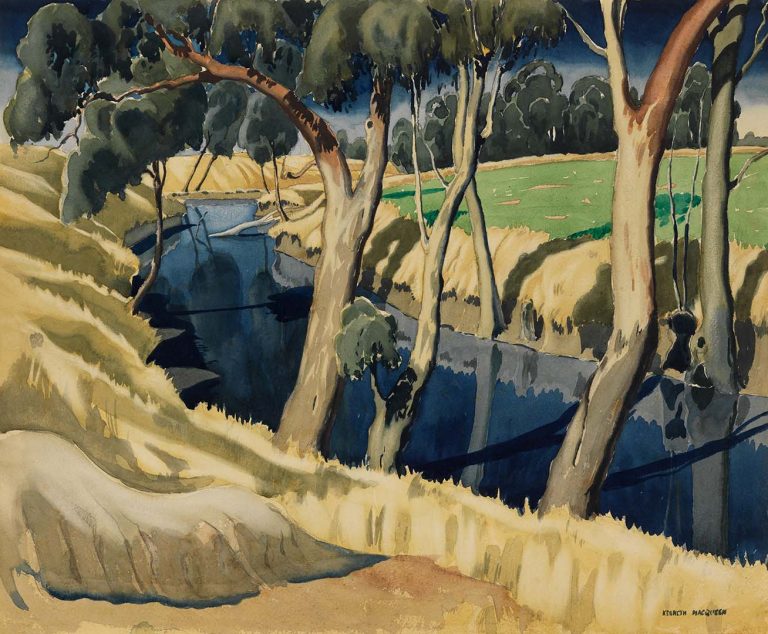We acknowledge the Traditional Owners of the land on which the Queensland Art Gallery | Gallery of Modern Art stands and recognise the creative contribution First Australians make to the art and culture of this country.

Kenneth Macqueen / Australia 1897–1960 / Mingimarny Creek c.1939 / Watercolour over pencil / 39.1 x 47.3cm / Purchased 1956 / Collection: Queensland Art Gallery / © QAG
Kenneth MacqueenMingimarny Creek c.1939
Not Currently on Display
Mingimarny Creek is one of the watercourses that flows through the Mount Emlyn property owned by Kenneth Macqueen and his brother Jack. Macqueen made many watercolours that display his intimate relationship with the surrounding landscape. He embraced the beauty and colour of the Darling Downs, but also portrayed the challenges of life on the land. The Macqueens were keenly aware of the susceptibility of their land to environmental hazards — soil erosion and droughts presented particular concerns.
In Mingimarny Creek c.1939, the detrimental effects of past erosion are evident. However, the creek is full, the grass is green, and the trees are heavy with lush foliage. The painting is a celebration of the abundance of nature, and the long shadows cast by the trees, together with the reflections on the water, impart a peaceful atmosphere.
Born in Ballarat, Victoria, in 1897, Kenneth Macqueen began to take a serious interest in watercolour painting as a 10-year-old, after watching a young friend use the medium. In 1909, Macqueen’s family moved to Sydney, where he received professional tuition in drawing from a commercial artist, Mr Beecroft.
In 1916, Macqueen enlisted with the Australian Imperial Force and was sent to France where he served with the 12th Army Brigade, Australian Field Artillery. He continued to paint, producing small watercolours in the field, and he pursued his art studies through a London-based correspondence course.
Macqueen returned to Australia in 1919 and, in 1922, he and his brother Jack settled on a property at Mount Emlyn, near Millmerran on Queensland’s Darling Downs. This area and the nearby coast provided his main subject matter from this time. He maintained a national profile, exhibiting regularly in Sydney and in other state capitals. His version of Modernism brought a fresh approach to the genre of landscape painting. His work was included in the exhibition ‘Art of Australia: 1788–1941’, which travelled to the United States and Canada in 1941. His watercolour Cabbage gums and cypress pines c.1940 was subsequently acquired by the Metropolitan Museum of Art, New York.